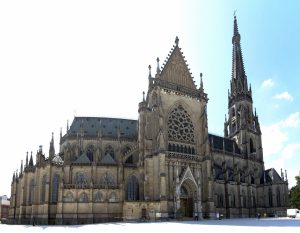3.6 Mein Körper

Guten Tag!
Zum Aufwärmen machen wir unseren Tagesminiplausch und eine Wiederholung.
Wiederholung
In the previous lesson, you learned how to express intensity of feelings, ask someone how often they feel certain feelings, and say how often you feel certain feelings. Let’s review!
Jetzt bist du dran!
In your journal, answer the question “Wie geht’s?” with a nuanced answer (what’s the intensity of that feeling – sehr, etwas, ein bißchen, nicht, gar nicht). Begin the sentence with, Ich bin… Then state how often you feel that way (immer – oft – manchmal – nie).
Lektionsüberblick
Now that we able able to say something about our inner selves, in this lesson, we will learn how to talk about the physical body in order to describe our physical appearance and generally understand when someone is being described and sometimes understand the description. In the end, you will be able to 1) recognize the words for body parts and name some and 2) state how many you have of each.
1) Körperteile nennen
Take a look at the Körperteile and their names below. Which body parts do you recognize because the words are cognates, therefore similar to English? Which body part names look different? Listen to the recording and repeat the words aloud. Some of the cognates will sound quite different! As you say the words, hold up or point to that body part.
Watch Stephan, a student in Germany, describe Körperteile in this fun, relaxed video.
You can check out Deutsche Welle for extra practice with Körperteile.
Jetzt bist du dran!
2) Körperteile zählen
You might remember from our earlier unit on Familie und Herkunft that there are different ways to make plurals in German.
Jetzt bist du dran!
Österreich im Blickpunkt: Eine Köpfung im Dom (A beheading in the cathedral)
 crowning ist eine Marienskulptur der österreichischen Performance- und Sprachkünstlerin Esther Strauß. Sie wurde für eine Ausstellung im Juni/Juli 2024 im Kunstraum des Mariä-Empfängnis-Doms in Linz entwickelt. Die Skulptur stellt eine natürliche Geburt Jesu dar. Die Installation wurde kontrovers diskutiert; konservative Katholiken forderten ihre Entfernung aus dem Dom. Eine unbekannte Person zerstörte das Kunstwerk wenige Tage nach seiner Aufstellung. Die etwa 30 cm große Skulptur aus Lindenholz wurde von der Bildhauerin Theresa Limberger geschnitzt und bemalt und von der Künstlerin und Restauratorin Klara Kohler patiniert.
crowning ist eine Marienskulptur der österreichischen Performance- und Sprachkünstlerin Esther Strauß. Sie wurde für eine Ausstellung im Juni/Juli 2024 im Kunstraum des Mariä-Empfängnis-Doms in Linz entwickelt. Die Skulptur stellt eine natürliche Geburt Jesu dar. Die Installation wurde kontrovers diskutiert; konservative Katholiken forderten ihre Entfernung aus dem Dom. Eine unbekannte Person zerstörte das Kunstwerk wenige Tage nach seiner Aufstellung. Die etwa 30 cm große Skulptur aus Lindenholz wurde von der Bildhauerin Theresa Limberger geschnitzt und bemalt und von der Künstlerin und Restauratorin Klara Kohler patiniert.
crowning is a sculpture of the Virgin Mary by the Austrian performance artist and writer Esther Strauß. It was developed for an exhibition in the art room of the Cathedral of Immaculate Conception in Linz in June/July 2024. The sculpture depicts the natural birth of Jesus. The installation was controversial; conservative Catholics demanded its removal from the cathedral. An unknown person destroyed the artwork shortly after the exhibit opened. The sculpture is approximately 12 inches tall and is made of linden wood. It was carved and painted by sculptress Theresa Limberger and patinated by the artist and conservator Klara Kohler.
Zum Schluß
Imagine we have invented a way to speak to aliens – but we can’t see them. They seem to have the same kinds of body parts we have, but not necessarily the same number. Listen to the alien’s description of itself first and draw what you hear. Then read the text and confirm.

*As you conclude this lesson, don’t forget to check Canvas!*
Before you go, check out…
Learn with Anja: Der Körper

Media Attributions:
- Body Parts presentation adapted from Willkommen: Deutsch für alle © 2020 by Claudia Kost and Crystal Sawatzky is licensed under a CC BY-NC-SA 4.0 International License.
- Körperteile video from Deutsch im Blick, University of Texas at Austin, by Zsuzsanna Abrams licensed under CC BY 4.0 International License.
- crowning text adapted from Wikipedia, licensed under CC BY-SA 4.0 International License.
Media Attributions
- Private: 1010-at-banner-large
- Neuer_Dom_Linz © H. Raab is licensed under a CC BY-SA (Attribution ShareAlike) license

